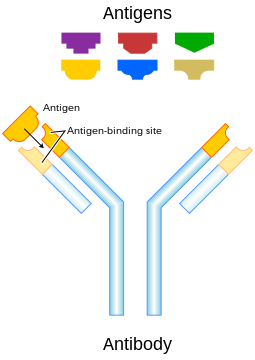Reminder: Pharmboy is available to chat with Members, comments are found below each post.
Antibodies (also known as immunoglobulins) are large Y-shaped protein secreted by a white blood cell known as a plasma cell to identify and neutralize foreign objects (i.e., bacteria, viruses and cancer). The antibody recognizes a unique part of the foreign target, termed an antigen (Figure 1). Each antibody’s “Y” end contains a paratope (lock) that is specific for one particular antigen epitope (key), allowing these structures to bind. This binding mechanism allows the antibody to ‘tag’ a microbe, an infected cell, or foreign cell (cancer) for attack by other parts of the immune system, or can neutralize its target directly (for example, by blocking a part of a microbe that is essential for its invasion and survival). The production of antibodies is the main function of the humoral immune system.
Figure 1. Plasma cell and an antibody binding to an antigen.


Antibodies can occur in two physical forms, a soluble form that is secreted from the cell, and a membrane-bound form that is attached to the surface of a B cell and is referred to as the B cell receptor (BCR). The BCR is only found on the surface of B cells and facilitates the activation of these cells and their subsequent differentiation into either antibody factories called plasma cells, or memory B cells that will survive in the body and remember that same antigen so the B cells can respond faster upon future exposure (this is how immunity works, i.e., small pox). In most cases, interaction of the B cell with a T helper cell is necessary to produce full activation of the B cell and, therefore, antibody generation following antigen binding. Soluble antibodies are released into the blood and tissue fluids, as well as many secretions to continue to survey for invading microorganisms.
Scientists figured out long ago that B cells could make specific antibodies, and thus the modern monoclonal antibody (mAb) production was born and the cancer fighting field exploded with optimism. About 10 years ago, Rituxan was approved and it marked the birth of a multi-billion dollar market. Since then, 8 additional antibodies have joined Rituxan. The market is currently dominated by a specific flavor of antibodies termed “naked” antibodies, which represent a fraction of the different…



